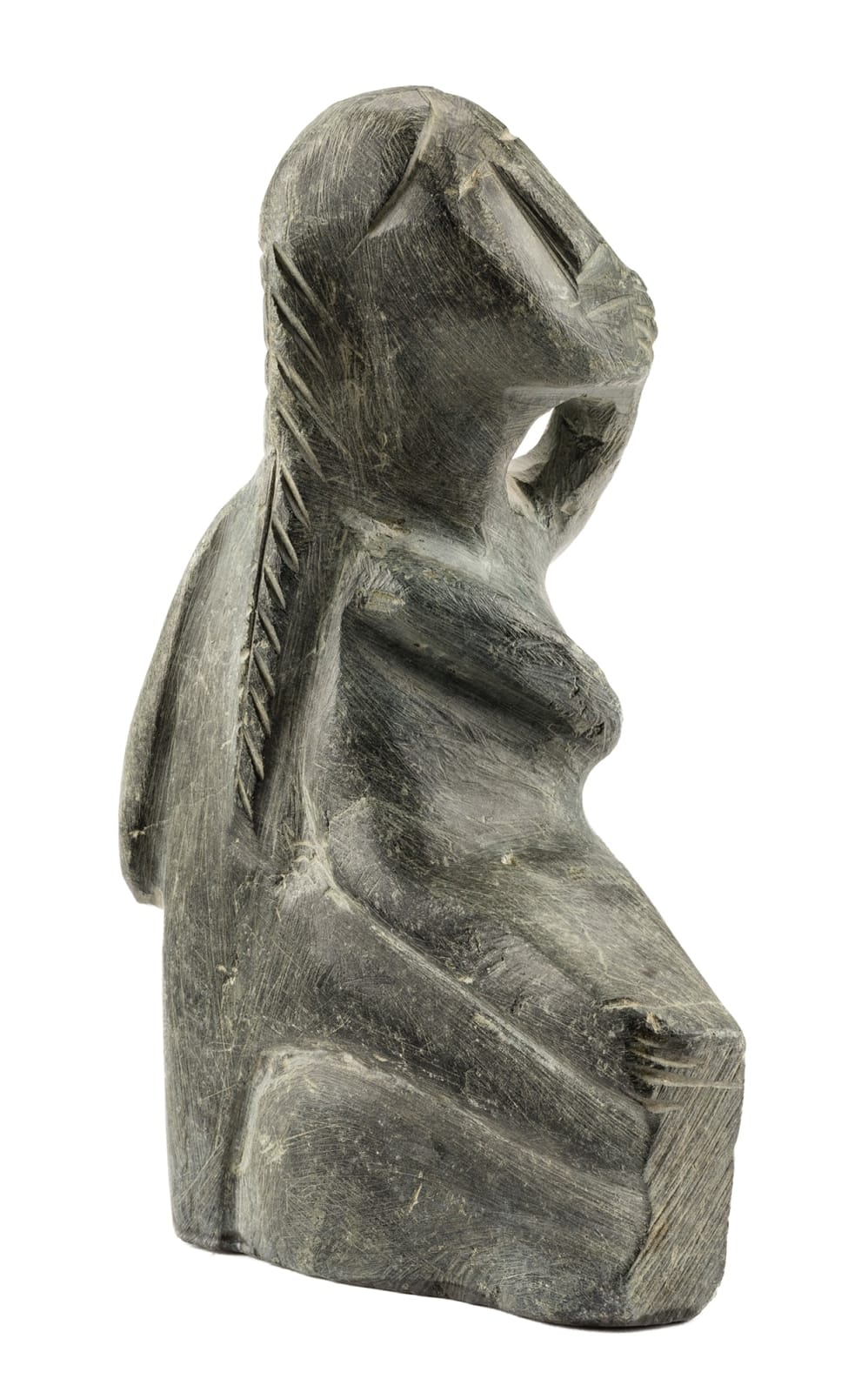-
Artworks
ELIZABETH NUTARAALUK AULATJUT (1914-1998) ARVIAT (ESKIMO POINT)
Woman with Child, c. 1970-72stone, 6.75 x 4.5 x 2 in (17.1 x 11.4 x 5.1 cm)
unsigned.
LOT 13
ESTIMATE: $5,000 — $8,000
PRICE REALIZED: $10,800.00Further images
Each artist has a different style and way of carving. My style is to carve a woman with her hair in braids carrying a child on her back. This idea comes from having carried my own children and from my memories of playing with them. In my younger days I adored my children and that’s probably why I love to carve a mother and a child. If I want to carve a particular position of a mother with her child, such as the feeding of the infant, I would observe that position before carving it [1].
Although her works are best known for their stripped-down, primal qualities (especially those sculptures carved after the artist began to lose her strength and eyesight), some early examples can be surprisingly elegant. This masterpiece dates from the very early 1970s, when Nutaraaluk’s carving style was at its most lyrical. While there is an unmistakable rawness to the work – the artist has made no attempt to hide the marks of her carving tools – this Mother and Child is ultimately remarkable for a delicacy that borders almost on fragility. Nutaraaluk’s accounts of her family’s suffering in the 1950s are heart-rending and left an indelible mark on her and on her art, so it is perhaps the fragility of life itself that is expressed in this poignant and beautiful little sculpture. It’s an interesting and unusually animated composition for the artist: the kneeling mother gently pulls her head away as her rambunctious child tugs at her chin, perhaps hoping to be nursed. Nutaraaluk’s signature braid and hatch mark hands are already clearly in evidence in this early classic work.
The grande dame among carvers in Arviat, Elizabeth Nutaraaluk was the wife of Aulatjut, the leader of the famous Ennadai Lake band of inland Ahiarmiut (Caribou Inuit). She and her family suffered famine and several forced relocations in the 1950s, and finally settled in Arviat in the early 1960s.
1. The artist quoted in Driscoll, Eskimo Point/Arviat, (WAG, 1982), p. 23.
References: Important examples of Nutaraaluk’s Mother and Child compositions are illustrated in many publications. For a fine example in the Sarick Collection at the AGO, see Ingo Hessel, Inuit Art: An Introduction, (Douglas & McIntyre, 1998), fig. 104; also illustrated in Julian Spalding, The Best Art You've Never Seen: 101 Hidden Treasures from Around the World, (London: Rough Guides, 2010), p. 191. See Marion Scott Gallery, Vision and Form, (Vancouver, 2003), p. 122; and Inuit Gallery of Vancouver, Classic Inuit (2005), cat. 30. For another see Ingo Hessel, Arctic Spirit, (Douglas & McIntyre/Heard Museum, 2006) cat. 39. For other fine stone sculptures by the artist see First Arts Auction, July 2020, Lots 41 and 59.Provenance
Private Collection, Canada;
Inuit Gallery of Vancouver;
Acquired from the above by John and Joyce Price, Seattle, 2005.Publications
Inuit Gallery of Vancouver, Classic Inuit: Sculpture & Graphics from the 1950s to the Present 2005, cat. 61 and front cover.
Join our mailing list
* denotes required fields
We will process the personal data you have supplied in accordance with our privacy policy (available on request). You can unsubscribe or change your preferences at any time by clicking the link in our emails.










